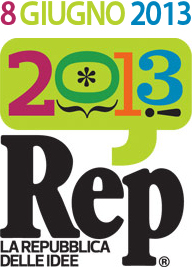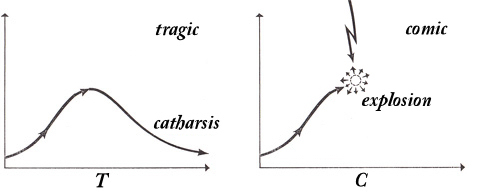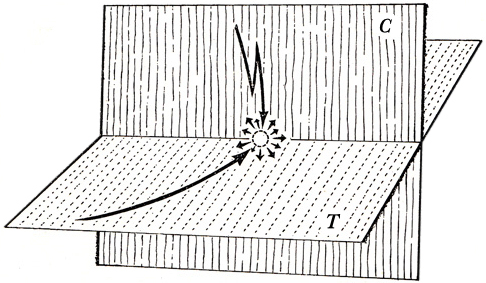
I was moved to tears and laughed at the same time. Then I speculated about the trick. How did Serena Dandini produce in me – and in the other 1,500 spectators – such conflicting emotions?
The occasion was the show “Ferite a morte” (“Injured to death”), presented Saturday ago at Teatro Verdi in Florence, as part of “La Repubblica delle Idee” event. Actresses and journalists who took turns on stage (1) read the stories of many women killed by a man, telling – from a hypothetical paradise – the harassment suffered. With the clarity of someone who has abandoned the earthly things, they can each speak in tragicomic tones, which move to laughter and emotion through careful modulation of the narrative register.
In his book The Act of Creation (2) Arthur Koestler tried to explain what happens in those magical moments where opposites meet. In two charts, the philosopher describes the emotionally trend of the spectator when enjoying a tragedy and a comic situation:

The tragedy is based on a crescendo of emotional tension, until its dissolution in catharsis. The humor follows a similar trajectory only in a first part, up to a breaking point – represented by a lightning bolt that stops the action: it’s the joke that breaks the mold and turns everything upside down, causing a laughter.
According to Koestler, some artists are able to combine the two trajectories. The secret
the perceiving of a situation or idea […] in two self-consistent but habitually incompatible frames of reference, [T] and [C]. The event […], in which the two intersect, is made to vibrate simultaneously on two different wavelengths, as it were. While this unusual situation lasts, [the event] is not merely linked to one associative context, but bisociated with two. (3)

In the case of “Ferite a morte,” Serena Dandini has successfully placed each femicide in two opposite contexts, causing them to vibrate in unison and producing that feeling of emotion woven to laugher which so captured me.
An example of this intersection can be found in Paola Cortellesi’s monologue from the show, which happily combines the drama of claustrophobia (she has been killed and thrown in a pit) and a deep nostalgia… for the plasma TV her husband can still enjoy!
1. Lucia Annunziata, Anna Bandettini, Geppi Cucciari, Annalisa Cuzzocrea, Concita De Gregorio, Orsetta De Rossi, Angela Finocchiaro, Iaia Forte, Silvia Paoli, Laura Pertici, Claudia Riconda e Giulia Santerini
2. Arthur Koestler, The Act of Creation, Macmillan, New York 1964.
3. Arthur Koestler quoted in Maria Popova, “How Creativity in Humor, Art, and Science Works: Arthur Koestler’s Theory of Bisociation” in Brain Pickings.
BY-NC-SA 4.0 • Attribution-NonCommercial-ShareAlike 4.0 International